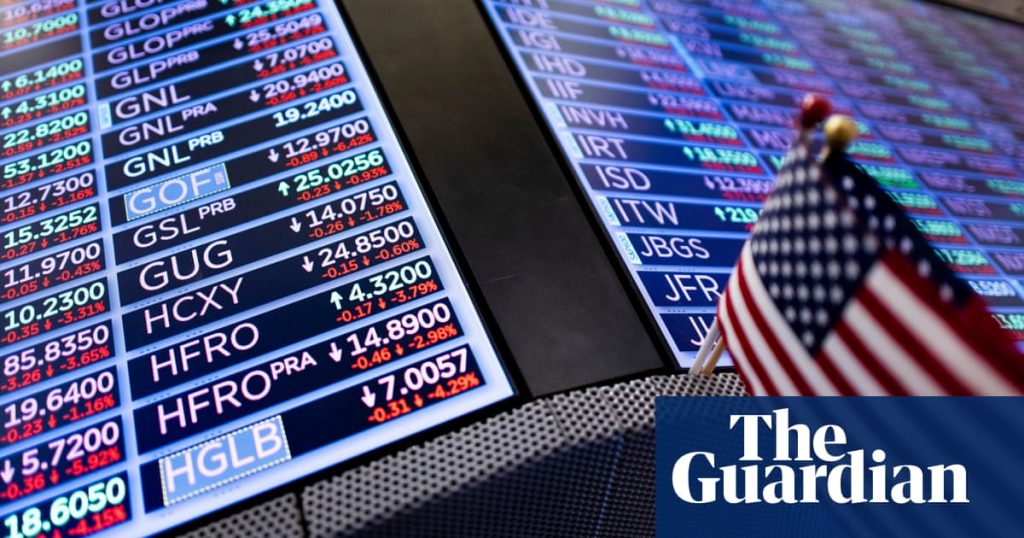The intensifying trade war led by Donald Trump has sent global financial markets into their most severe decline since the onset of the Covid pandemic five years ago.
Economists are drawing comparisons to the 1929 Wall Street crash and the subsequent Great Depression of the 1930s, as Trump’s “liberation day” tariff strategy raises fears of a worldwide recession.
Since Trump’s address from the Rose Garden last Wednesday, global stock markets have lost over $5 trillion (£4 trillion) in value, with investors anticipating further turbulence as Washington shows no signs of retreating.
In Wall Street, the S&P 500 index is nearing bear market territory, defined as a drop of more than 20% from its most recent peak, marking one of the largest stock market downturns in history.
1929 Wall Street Crash
The Wall Street crash of 1929 was the most significant setback for the global economy in the modern industrial era. Triggered by rampant speculative stock buying, the bubble burst, leading to the Great Depression and the economic conditions that culminated in World War II. On “Black Thursday,” October 24, the Dow Jones industrial average plummeted by 11%, followed by a 13% drop on the following Monday and another 11% on Tuesday. The market did not hit rock bottom until June 1932, with companies on the New York Stock Exchange losing 90% of their value.
1987 ‘Black Monday’
The first major global financial crash of modern times occurred during the speculative bubble of the booming 1980s. On October 19, the Dow Jones experienced its largest single-day decline, falling by 22%. The London market was similarly affected; the situation was worsened by the stock exchange’s closure on Friday due to the Great Storm of 1987. As traders struggled to return to their desks amid chaotic trading conditions exacerbated by automated trading systems, the FTSE 100 fell by 10.8% that Monday and another 12.2% the following day.
2000 Dotcom Crash and 9/11
The excitement surrounding the 1990s stock market expansion due to the rise of internet firms led to the FTSE 100 reaching a high of 6,930.2 on December 30, 1999, a record that stood for 15 years. However, the dotcom bubble burst in March 2000, and the September 11 terrorist attacks in 2001 further decreased the index to a low of 3,287 as military actions in Iraq were being planned in 2003. Investors are now reminded of this period as they observe the rapid rise and fall of the “magnificent seven” US tech stocks.
2008 Financial Crisis
The collapse of Lehman Brothers on September 15, 2008, marked a pivotal moment in the most severe financial crisis since World War II. The global markets had been in turmoil due to the persistent credit crunch rooted in the sub-prime mortgage crisis. Though the FTSE 100 fell by only 4% on the day of Lehman’s bankruptcy, it ultimately lost almost a third of its value throughout 2008, as bank runs and corporate failures triggered steep trading losses, highlighted by a nearly 9% drop on October 10 at the height of the crisis.
2016 Brexit Vote
The unexpected decision by Britain to leave the EU caused the pound to plummet to a 31-year low, resulting in a loss of over $2 trillion (£1.57 trillion) in global financial markets, particularly impacting the FTSE 100 and major European trading centers. Initially, the FTSE 100 dropped by 8% within moments of opening, but it later regained some losses after assurances from the then Bank of England governor, Mark Carney, that the bank would act to stabilize the economy, leading to a 3.2% decline at the end of the day.
2020 Covid Pandemic
The global economy was forced to shut down during the Covid pandemic, igniting panic across financial markets and resulting in the most profound recession since at least the Great Depression of the 1930s. Major indices plummeted in mere hours, with the FTSE 100 losing over eight years of gains within a month. During this period, global stocks experienced their best and worst trading sessions over ten years. The FTSE 100 saw its most significant daily decline since Black Monday at nearly 11%, while the Dow fell around 13% on March 16. However, vigorous intervention from central banks and governments greatly aided in recovering the situation.



